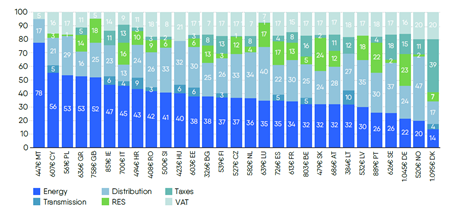During the last months, we are hearing about peaks in the electricity price in some countries. Not long ago, we heard about the negative prices due to high renewable penetration. This volatility will be with us for some time and this news is very much in the agenda of media and governments, but what is the real effect in the price of the electricity?

Although the way the different electrical markets are created would take a whole blog, and to debate how a fuel-based system is not the best fit for a renewable-based system would give for many days of debate, the purpose of this article is to reflect on something that is not commonly talked about, but which on average is so important and it will become increasingly so in the following years; the importance of the distribution costs.
The figure below was extracted from an Eurelectric position paper (The value of the grid) [1] published in June 2019 where the price of electricity offers for households in capital cities during November and December of 2017 was brokendown in the different components of the bill.

Source: ACER/CEER Annual Report on Electricity and Gas Retails Market Volume, 2018.
This figure caught my attention, as in some countries the price of the distribution and transmission tariff was already more expensive than the cost of the energy consumed. Funnily, I was living in one of those countries, and I was often hearing in the media how different lobbies and politicians argued about the importance of the price of the electricity and the problems that renewables brought into the system, the importance of low electricity prices for keeping a good industrial cost… but I never heard that I, the end user, paid more for the distribution fees than for the energy I consumed on average.
If you look closely to the figure, in many countries, there was no significant difference between energy and distribution costs. If we understand that taxes and VAT in most of these countries are translated to a percentage of the total amount we pay, the total cost of the distribution fees is not neglectable when talking about the price of the electricity for every final consumer in Europe.
The media always focuses on the sudden peaks (sometimes even valleys) of electricity and for some consumers of electricity this is an important issue, but many consumers still don’t understand why their bills are not changing so much month after month. The reason may be explained by the boiling frog fable. This fable tells how a frog that is put suddenly into boiling water will jump out, but if the frog is put in water which is slowly brought to the boil, it will not perceive the danger and will be cooked to death. Similarly, news are driven by sudden changes, but trends that happen gradually usually don´t get the same attention.
…so, why is this important now?
Perhaps it is more important now than ever, since the problem mentioned above only just begun. We are in the course of the fight against the climate change. The clear consequence of this fight is electrification, as this is the fastest way to reduce the CO2 emissions.
… but what does it mean?
The shift to an “electricity-driven society” will require “efforts”. Several distribution and transmission operators, as well as electricity associations, have pointed out that the electricity grid needs to invest more than ever to cope with this necessary transition. Some figures, in Europe alone, quantify that grid investments need to be increased in the range of 50 to 70% (source Eurelectric) over the next decade… we are talking about €400Bn
‘I get it… but what does it mean to me as an end customer?
We should remind the readers that the distribution and transmission fees are mainly the translation of the investments and operation costs on the distribution and transmission networks over time. In my case, I received last spring a letter from my electrical distribution operator stating that my bill will increase 1€ per month (12 fix euros +~30% tax per year) due to adjustments in the investments needs. Some other companies have taken more drastic decisions increasing network tariffs by 10%… my main concern is that this is not the last letter that we will receive on this matter. To the point that sooner rather than later, the previous figure will clearly show distribution fees as the most expensive part of my bill and the frog will belatedly realize the problem.
I am not saying that this is not the way to go. In fact, from an economic point of view, I am sure there will be some savings in fuel consumption and in health that for sure will compensate for the increases in electrical distribution fees (not to mention the repayment that humans should make for borrowing, polluting and wasting our mother earth’s resources). The question we should ask ourselves is: Is there a better way to do it? Can we do things in a smarter way by not investing as much as we foresee today?
At Plexigrid we strongly believe so. In fact, we believe that consumers of electricity can benefit from this electrification journey. Distribution networks are in many cases over dimensioned and there is room to play with the available capacity. All that is needed is to start integrating the different parts of the electricity bill (energy and distribution fees) as one. There are more opportunities to optimize holistically rather than separately. Making the flexibility available to the distribution networks can reduce peaks, reduce the needs for investments, and reduce the electrical losses in the system which by the way, is also something that we hiddenly pay for in our bill.
This concept is not new, telecom networks already made a similar journey several years ago, for example, your streaming services have priority over the software updates in your home resulting in lower internet fees due to smarter allocation of capacity.
What I am saying here is that whilst many people keep talking about prices of electricity generation, it is time to take action on the distribution fees; before it is too late, and the frog is already boiled.
[1] Eurelectric report – The value of the grid. https://www.eurelectric.org/news/value-of-the-grid/
[2] ACER/CEER Annual Report on Electricity and Gas Retails Market Volume, 2018.

